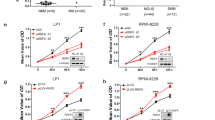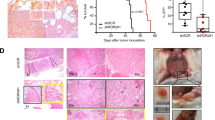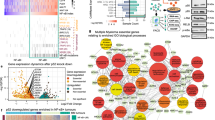Abstract
Multiple myeloma (MM) is a paradigm for a malignant disease that exploits external stimuli of the microenvironment for growth and survival. A thorough understanding of the complex interactions between malignant plasma cells and their surrounding requires a detailed analysis of the transcriptional response of myeloma cells to environmental signals. We determined the changes in gene expression induced by interleukin (IL)-6, tumor necrosis factor-α, IL-21 or co-culture with bone marrow stromal cells in myeloma cell lines. Among a limited set of genes that were consistently activated in response to growth factors, a prominent transcriptional target of cytokine-induced signaling in myeloma cells was the gene encoding the serine/threonine kinase serum/glucocorticoid-regulated kinase 1 (SGK1), which is a down-stream effector of PI3-kinase. We could demonstrate a rapid, strong and sustained induction of SGK1 in the cell lines INA-6, ANBL-6, IH-1, OH-2 and MM.1S as well as in primary myeloma cells. Pharmacologic inhibition of the Janus kinase/signal transducer and activator of transcription (JAK/STAT) pathway abolished STAT3 phosphorylation and SGK1 induction. In addition, small hairpin RNA (shRNA)-mediated knock-down of STAT3 reduced basal and induced SGK1 levels. Furthermore, downregulation of SGK1 by shRNAs resulted in decreased proliferation of myeloma cell lines and reduced cell numbers. On the molecular level, this was reflected by the induction of cell cycle inhibitory genes, for example, CDKNA1/p21, whereas positively acting factors such as CDK6 and RBL2/p130 were downregulated. Our results indicate that SGK1 is a highly cytokine-responsive gene in myeloma cells promoting their malignant growth.
This is a preview of subscription content, access via your institution
Access options
Subscribe to this journal
Receive 50 print issues and online access
$259.00 per year
only $5.18 per issue
Buy this article
- Purchase on Springer Link
- Instant access to full article PDF
Prices may be subject to local taxes which are calculated during checkout




Similar content being viewed by others
References
Brocke-Heidrich K, Kretzschmar AK, Pfeifer G, Henze C, Löffler D, Koczan D et al. (2004). Interleukin-6-dependent gene expression profiles in multiple myeloma INA-6 cells reveal a Bcl-2 family-independent survival pathway closely associated with Stat3 activation. Blood 103: 242–251.
Brunet A, Park J, Tran H, Hu LS, Hemmings BA, Greenberg ME . (2001). Protein kinase SGK mediates survival signals by phosphorylating the forkhead transcription factor FKHRL1 (FOXO3a). Mol Cell Biol 21: 952–965.
Catlett-Falcone R, Landowski TH, Oshiro MM, Turkson J, Levitzki A, Savino R et al. (1999). Constitutive activation of Stat3 signaling confers resistance to apoptosis in human U266 myeloma cells. Immunity 10: 105–115.
Chatterjee M, Stühmer T, Herrmann P, Bommert K, Dörken B, Bargou RC . (2004). Combined disruption of both the MEK/ERK and the IL-6R/STAT3 pathways is required to induce apoptosis of multiple myeloma cells in the presence of bone marrow stromal cells. Blood 104: 3712–3721.
Hideshima T, Mitsiades C, Tonon G, Richardson PG, Anderson KC . (2007). Understanding multiple myeloma pathogenesis in the bone marrow to identify new therapeutic targets. Nat Rev Cancer 7: 585–598.
Hideshima T, Nakamura N, Chauhan D, Anderson KC . (2001). Biologic sequelae of interleukin-6 induced PI3-K/Akt signaling in multiple myeloma. Oncogene 20: 5991–6000.
Hsu J, Shi Y, Krajewski S, Renner S, Fisher M, Reed JC et al. (2001). The AKT kinase is activated in multiple myeloma tumor cells. Blood 98: 2853–2855.
Kobayashi T, Cohen P . (1999). Activation of serum- and glucocorticoid-regulated protein kinase by agonists that activate phosphatidylinositide 3-kinase is mediated by 3-phosphoinositide-dependent protein kinase-1 (PDK1) and PDK2. Biochem J 339 (Part 2): 319–328.
Leong ML, Maiyar AC, Kim B, O'Keeffe BA, Firestone GL . (2003). Expression of the serum- and glucocorticoid-inducible protein kinase, Sgk, is a cell survival response to multiple types of environmental stress stimuli in mammary epithelial cells. J Biol Chem 278: 5871–5882.
Meng F, Yamagiwa Y, Taffetani S, Han J, Patel T . (2005). IL-6 activates serum and glucocorticoid kinase via p38alpha mitogen-activated protein kinase pathway. Am J Physiol Cell Physiol 289: C971–C981.
Ocio EM, Mateos MV, Maiso P, Pandiella A, San-Miguel JF . (2008). New drugs in multiple myeloma: mechanisms of action and phase I/II clinical findings. Lancet Oncol 9: 1157–1165.
Ogata A, Chauhan D, Urashima M, Teoh G, Treon SP, Anderson KC . (1997). Blockade of mitogen-activated protein kinase cascade signaling in interleukin 6-independent multiple myeloma cells. Clin Cancer Res 3: 1017–1022.
Park J, Leong ML, Buse P, Maiyar AC, Firestone GL, Hemmings BA . (1999). Serum and glucocorticoid-inducible kinase (SGK) is a target of the PI 3-kinase-stimulated signaling pathway. EMBO J 18: 3024–3033.
Podar K, Chauhan D, Anderson KC . (2009). Bone marrow microenvironment and the identification of new targets for myeloma therapy. Leukemia 23: 10–24.
Sahoo S, Brickley DR, Kocherginsky M, Conzen SD . (2005). Coordinate expression of the PI3-kinase downstream effectors serum and glucocorticoid-induced kinase (SGK-1) and Akt-1 in human breast cancer. Eur J Cancer 41: 2754–2759.
Shanmugam I, Cheng G, Terranova PF, Thrasher JB, Thomas CP, Li B . (2007). Serum/glucocorticoid-induced protein kinase-1 facilitates androgen receptor-dependent cell survival. Cell Death Differ 14: 2085–2094.
Tu Y, Gardner A, Lichtenstein A . (2000). The phosphatidylinositol 3-kinase/AKT kinase pathway in multiple myeloma plasma cells: roles in cytokine-dependent survival and proliferative responses. Cancer Res 60: 6763–6770.
van Zaanen HC, Lokhorst HM, Aarden LA, Rensink HJ, Warnaar SO, van der Lelie J et al. (1998). Chimaeric anti-interleukin 6 monoclonal antibodies in the treatment of advanced multiple myeloma: a phase I dose-escalating study. Br J Haematol 102: 783–790.
Vasudevan KM, Barbie DA, Davies MA, Rabinovsky R, McNear CJ, Kim JJ et al. (2009). AKT-independent signaling downstream of oncogenic PIK3CA mutations in human cancer. Cancer Cell 16: 21–32.
Webster MK, Goya L, Ge Y, Maiyar AC, Firestone GL . (1993). Characterization of sgk, a novel member of the serine/threonine protein kinase gene family which is transcriptionally induced by glucocorticoids and serum. Mol Cell Biol 13: 2031–2040.
Wu W, Chaudhuri S, Brickley DR, Pang D, Karrison T, Conzen SD . (2004). Microarray analysis reveals glucocorticoid-regulated survival genes that are associated with inhibition of apoptosis in breast epithelial cells. Cancer Res 64: 1757–1764.
Zöllinger A, Stühmer T, Chatterjee M, Gattenlöhner S, Haralambieva E, Müller-Hermelink HK et al. (2008). Combined functional and molecular analysis of tumor cell signaling defines 2 distinct myeloma subgroups: Akt-dependent and Akt-independent multiple myeloma. Blood 112: 3403–3411.
Acknowledgements
We thank Brigitte Wollert-Wulf, Mandy Terne, Pia Herrmann (Berlin), Berit Størdal and Hanne Hella (Trondheim) for excellent technical assistance and Hans-Peter Rahn (Berlin) for cell sorting. Reuven Agami (Amsterdam, The Netherlands) kindly provided the pSUPER vector and Matthias Truss (Berlin) the pRepH1 construct. This work was supported by grants from the Deutsche Krebshilfe (10-2225-Ja 1), the Berlin Cancer Society, the Deutsche Forschungsgemeinschaft (KFO 216 to TS, MC and RCB), the Norwegian Cancer Society, the Cancer Fund of St Olavs Hospital, Trondheim, and the Research Council of Norway.
Author information
Authors and Affiliations
Corresponding author
Ethics declarations
Competing interests
The authors declare no conflict of interest.
Additional information
Supplementary Information accompanies the paper on the Oncogene website
Supplementary information
Rights and permissions
About this article
Cite this article
Fagerli, UM., Ullrich, K., Stühmer, T. et al. Serum/glucocorticoid-regulated kinase 1 (SGK1) is a prominent target gene of the transcriptional response to cytokines in multiple myeloma and supports the growth of myeloma cells. Oncogene 30, 3198–3206 (2011). https://doi.org/10.1038/onc.2011.79
Received:
Revised:
Accepted:
Published:
Issue Date:
DOI: https://doi.org/10.1038/onc.2011.79
Keywords
This article is cited by
-
Crosstalk between glucocorticoid and mineralocorticoid receptors boosts glucocorticoid-induced killing of multiple myeloma cells
Cellular and Molecular Life Sciences (2023)
-
SGK1, autophagy and cancer: an overview
Molecular Biology Reports (2022)
-
IL-21 enhances STAT3/Blimp-1 signaling pathway in B cells and contributes to plasma cell differentiation in newly diagnosed patients with myasthenia gravis
Immunologic Research (2021)
-
RNF6 promotes myeloma cell proliferation and survival by inducing glucocorticoid receptor polyubiquitination
Acta Pharmacologica Sinica (2020)
-
SGK1 affects RAN/RANBP1/RANGAP1 via SP1 to play a critical role in pre-miRNA nuclear export: a new route of epigenomic regulation
Scientific Reports (2017)



